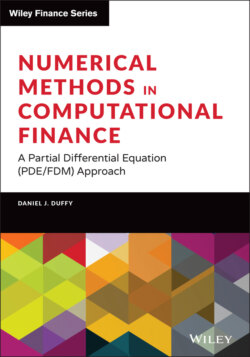Читать книгу Numerical Methods in Computational Finance - Daniel J. Duffy - Страница 96
Appendix : The Schrödinger Equation
ОглавлениеWe discuss the time-dependent one-dimensional Schrödinger PDE and its finite difference approximation by the Euler, fully implicit, and Crank–Nicolson schemes. We prove that only the Crank–Nicolson scheme is unitary (preserves norms) as discussed in Section 5.6.3 in the context of unitary matrices.
In some cases and applications we are interested in solving linear systems of equations where the coefficients are complex-valued. We take the example of the time-dependent linear Schrödinger equation in one dimension:
(5.23)
where:
Equation (5.23) describes the scattering of a one-dimensional wave packet by the potential . We have assumed for convenience that Planck's constant in this example.
We rewrite Equation (5.23) in the equivalent form:
(5.24)
The operator H is called the Hamiltonian operator, and it determines the time variation of the system. We are now interested in approximating Equation (5.24) using finite difference schemes. To this end, the explicit Euler FTCS scheme is given by:
(5.25)
while the implicit Euler BTCS scheme is given by:
or
(5.26)
or
Scheme (5.25) is unstable, while (5.26) is stable. However, neither scheme is unitary in the sense of the original problem; that is, the total probability of finding the particle somewhere is 1:
(5.27)
A remedy for this is to use the Cayley form (this is essentially the Crank–Nicolson scheme):
or
(5.28)
This scheme is unitary; you can check this by a bit of arithmetic using complex arithmetic.
The solution of (5.24) is:
(5.29)
and the solution of (5.28) is:
(5.30)
We can see that (5.30) is the (1,1) Padé approximant to the exponential function. Its absolute value is 1.
